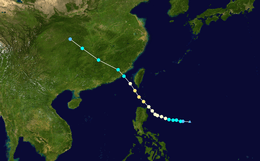Typhoon Iris (1959)
Typhoon Iris was a typhoon that formed in August 1959.
| Category 2 typhoon (SSHWS) | |
 track of Iris | |
| Formed | August 19, 1959 |
|---|---|
| Dissipated | August 23, 1959 |
| Highest winds | 1-minute sustained: 165 km/h (105 mph) |
| Lowest pressure | 965 hPa (mbar); 28.5 inHg |
| Part of the 1959 Pacific typhoon season | |
Meteorological history
In mid-August, a tropical disturbance developed within the Intertropical Convergence Zone over the Philippine Sea.[1] By August 19, the Japan Meteorological Agency (JMA) began monitoring this system as a tropical depression.[2][nb 1]Additionally, the Joint Typhoon Warning Center (JTWC) classified the system as a tropical storm.[4][nb 2] Initially, a strong ridge over Southeast Asia caused the storm to track slowly west-northwestward; however, the ridge gradually weakened over the following days.[1] The cyclone gradually strengthened to typhoon status on August 21, by which time it had developed a 32 km (20 mi) wide eye. Upon becoming a typhoon, the JTWC named the system Iris. Later on August 21, Iris turned northwestward as the ridge weakened and brushed the northeastern tip of Luzon.[1][4] On August 22, Iris attained its peak intensity as a Category 2 equivalent typhoon on the Saffir–Simpson Hurricane Scale with winds of 165 km/h (105 mph).[4] Later that day, United States Air Force reconnaissance plane flew into the storm and recorded a barometric pressure of 966 mbar (hPa; 28.53 inHg), the lowest in relation to the storm. After passing roughly 75 km (45 mi) south of Taiwan, known as Formosa at the time, Iris started weakening. Late on August 22, Iris made landfall near Kao-Chi, China as a strong tropical storm. The storm then rapidly transitioned into an extratropical cycloneover China before dissipating late on August 23.[1]
Impact
On August 21, Typhoon Iris brushed the northern coast of Luzon; however, there were no known reports of casualties or damage on land. Offshore, large swells produced by the storm were blamed on at least two shipwrecks.[6] Following the incidents, the United States Seventh Fleet were sent to search for survivors.[7] Near Palawan Island, at least 100 people drowned after a ferry sank; only 11 passengers were rescued. Five more people went missing near Quezon Province after their motorboat capsized.[6] Heavy rains from the typhoon spread across Taiwan on August 22, triggering significant flash flooding. Along the Haifenglun River, a railroad bridge was washed away.[8] Across the Pescadore Islands, approximately 1,000 people were left homeless.[9] Across Fujian Province, torrential rains from the typhoon led to catastrophic flooding that killed at least 720 people, injured 618 and left 996 others missing;[6][10] however, according to the National Oceanic and Atmospheric Administration, the death toll may be as high as 2,334.[11]
External links
Note
- The Japan Meteorological Agency is the official Regional Specialized Meteorological Center for the western Pacific Ocean.[3]
- The Joint Typhoon Warning Center is a joint United States Navy – United States Air Force task force that issues tropical cyclone warnings for the western Pacific Ocean and other regions.[5]
References
- "159 Annual Tropical Cyclone Report: Typhoon Iris" (PDF). Joint Typhoon Warning Center. United States Navy. 1960. pp. 46–49. Archived from the original (PDF) on June 6, 2011. Retrieved January 2, 2012.
- "RSMC Best Track Data - 1950-1959". Japan Meteorological Agency. June 1, 1989. Archived from the original (.TXT) on March 22, 2012. Retrieved January 2, 2012.
- "Annual Report on Activities of the RSMC Tokyo - Typhoon Center 2000" (PDF). Japan Meteorological Organization. February 2001. p. 3. Retrieved January 2, 2012.
- "Typhoon 08W 1959 Best Track" (TXT). Joint Typhoon Warning Center. United States Navy. 1960. Retrieved January 2, 2012.
- "Joint Typhoon Warning Center Mission Statement". Joint Typhoon Warning Center. United States Navy. 2011. Archived from the original on July 26, 2007. Retrieved January 1, 2012.
- "159 Annual Tropical Cyclone Report: Typhoon Iris" (PDF). Joint Typhoon Warning Center. United States Navy. 1960. pp. 46–49. Archived from the original (PDF) on June 6, 2011. Retrieved January 2, 2012.
- "Red Chinese Face Typhoon". Associated Press. Taipei, Taiwan: Youngstown Vindicator. August 23, 1959. p. 1. Retrieved January 5, 2011.
- "Rains Drench Taipei; Winds Lash Batanes". Associated Press. Taipei, Taiwan: Reading Eagle. August 22, 1959. p. 1. Retrieved January 5, 2011.
- "News In Brief". Taipei, Taiwan: Warsaw Times. August 25, 1959. p. 2. Retrieved January 4, 2011.
- "Typhoon Toll Reaches 2,334". Associated Press. Tokyo, Japan: The Washington Observer. September 1, 1959. p. 5. Retrieved January 5, 2011.
- "The Worst Natural Disasters by Death Toll" (PDF). National Oceanic and Atmospheric Administration. April 6, 2008. Retrieved January 5, 2011.
